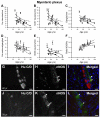Effect of age on the enteric nervous system of the human colon
- PMID: 19220755
- PMCID: PMC2776702
- DOI: 10.1111/j.1365-2982.2008.01245.x
Effect of age on the enteric nervous system of the human colon
Abstract
The effect of age on the anatomy and function of the human colon is incompletely understood. The prevalence of disorders in adults such as constipation increase with age but it is unclear if this is due to confounding factors or age-related structural defects. The aim of this study was to determine number and subtypes of enteric neurons and neuronal volumes in the human colon of different ages. Normal colon (descending and sigmoid) from 16 patients (nine male) was studied; ages 33-99. Antibodies to HuC/D, choline acetyltransferase (ChAT), neuronal nitric oxide synthase (nNOS), and protein gene product 9.5 were used. Effect of age was determined by testing for linear trends using regression analysis. In the myenteric plexus, number of Hu-positive neurons declined with age (slope = -1.3 neurons/mm/10 years, P = 0.03). The number of ChAT-positive neurons also declined with age (slope = -1.1 neurons/mm/10 years of age, P = 0.02). The number of nNOS-positive neurons did not decline with age. As a result, the ratio of nNOS to Hu increased (slope = 0.03 per 10 years of age, P = 0.01). In the submucosal plexus, the number of neurons did not decline with age (slope = -0.3 neurons/mm/10 years, P = 0.09). Volume of nerve fibres in the circular muscle and volume of neuronal structures in the myenteric plexus did not change with age. In conclusion, the number of neurons in the human colon declines with age with sparing of nNOS-positive neurons. This change was not accompanied by changes in total volume of neuronal structures suggesting compensatory changes in the remaining neurons.
Figures





References
-
- Priebe HJ. The aged cardiovascular risk patient. Br J Anaesth. 2000;85:763–78. - PubMed
-
- Izzo JL, Jr., Mitchell GF. Aging and arterial structure-function relations. Adv Cardiol. 2007;44:19–34. - PubMed
-
- Hall K, Wiley JW. Age-associated changes in gastrointestinal function. In: Hazzard JP, Blass WR, Ettinger WH, Hatter JB, Ous Pander JP, editors. Principles of Geriatric Medicine and Gerontology. 4th ed. McGraw-Hill; New York: 1999. pp. 835–42.
-
- Melkersson M, Andersson H, Bosaeus I, Falkheden T. Intestinal transit time in constipated and non-constipated geriatric patients. Scand J Gastroenterol. 1983;18:593–7. - PubMed
-
- Evans JM, Fleming KC, Talley NJ, Schleck CD, Zinsmeister AR, Melton LJ., 3rd Relation of colonic transit to functional bowel disease in older people: a population-based study. J Am Geriatr Soc. 1998;46:83–7. - PubMed
Publication types
MeSH terms
Substances
Grants and funding
LinkOut - more resources
Full Text Sources
Medical
Research Materials

